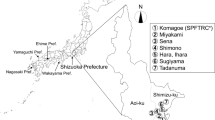Abstract
Serangium japonicum Chapin (Coleoptera: Coccinellidae) chiefly attacks whiteflies. This study monitored the adult occurrence of the ladybird and the citrus whitefly Dialeurodes citri (Ashmead) (Hemiptera: Aleyrodidae) in citrus groves in central Japan using sticky traps, thereby examining temporal relationships in their abundance. Many S. japonicum adults were captured in a pesticide-free grove where D. citri adults were very abundant, with few adults in neighboring (organic, reduced pesticide, and conventional) groves harboring small numbers of D. citri. The whitefly adults exhibited a large peak in numbers in late May to early June. Two peaks of the ladybird adult numbers were detected in late May to early June and late June to mid-July, −6 to 7 days, and nearly 1 month after the peak in whitefly adult numbers, respectively. The ladybird adults found during the first peak period would be those that visited citrus trees mainly for oviposition, and the adults caught during the second peak period would be those that newly emerged after consuming immature whiteflies at the larval stage. Based on a yearly change in adult numbers in the pesticide-free grove, i.e., a large increase in S. japonicum numbers followed by a rapid decline in D. citri numbers, the ladybird’s role in controlling the whitefly is discussed.




Similar content being viewed by others
References
Brown JK (1994) Current status of Bemisia tabaci as a plant pest and virus vector in agroecosystems worldwide. FAO Plant Prot Bull 42:3–32
Byrne DN, Bellows TS Jr (1991) Whitefly biology. Annu Rev Entomol 36:431–457
Dixon AFG (2000) Insect predator-prey dynamics: ladybird beetles and biological control. Cambridge Univ Press, Cambridge
Fazal S, Ren SX (2004) Interaction of Serangium japonicum (Coleoptera: Coccinellidae), an obligate predator of whitefly with immature stages of Eretmocerus sp. (Hymenoptera: Aphelinidae) within whitefly host (Homoptera: Aleyrodidae). Asian J Plant Sci 3:243–246
Gerling D, Alomar O, Arnó J (2001) Biological control of Bemisia tabaci using predators and parasitoids. Crop Prot 20:779–799
Horowitz AR, Kontsedalov S, Khasdan V, Ishaaya I (2005) Biotypes B and Q of Bemisia tabaci and their relevance to neonicotinoid and pyriproxyfen resistance. Arch Insect Biochem Physiol 58:216–225
Japan Meteorological Agency (2016) http://www.data.jma.go.jp/obd/stats/etrn/view/nml_amd_10d.php?prec_no=50&block_no=1243&year=&month=&day=&view=p1. Accessed 7 Jan 2017 (in Japanese)
Jones DR (2003) Plant viruses transmitted by whiteflies. Eur J Plant Pathol 109:195–219
Kaneko S, Ozawa A, Saito T, Tatara A, Katayama H, Doi M (2006) Relationship between the seasonal prevalence of the predacious coccinellid Pseudoscymnus hareja (Coleoptera: Coccinellidae) and the mulberry scale Pseudaulacaspis pentagona (Hemiptera: Diaspididae) in tea fields: monitoring using sticky traps. Appl Entomol Zool 41:621–626
Karatolos N, Denholm I, Williamson M, Nauen R, Gorman K (2010) Incidence and characterisation of resistance to neonicotinoid insecticides and pymetrozine in the greenhouse whitefly, Trialeurodes vaporariorum Westwood (Hemiptera: Aleyrodidae). Pest Manag Sci 66:1304–1307
Korenaga R, Koizumi M, Ushiyama K, Furuhashi K (1992) A handbook of diseases and insect pests of fruit trees. Citrus, loquat, and kiwifruit, vol 1. Japan Plant Protection Association, Tokyo (in Japanese)
Kurosawa Y, Hisamatsu S, Sasaji H (1985) The Coleoptera of Japan in color, vol III. Hoikusha Publishing, Osaka (in Japanese)
Naranjo SE (2001) Conservation and evaluation of natural enemies in IPM systems for Bemisia tabaci. Crop Prot 20:835–852
Ohgushi R, Ohkubo N (2005) The citrus whitefly. In: Nousangyoson Bunka Kyoukai (ed) A dictionary of diseases and insect pests of fruit trees in color. Citrus and kiwifruit, vol. 1, 2nd edn. Nousangyoson Bunka Kyoukai, Tokyo, pp 395–399 (in Japanese)
Ozawa A, Uchiyama T (2015) Monitoring of the ladybird beetle Serangium japonicum Chapin: a potential predator of the tea spiny whitefly, Aleurocanthus camelliae Kanmiya and Kasai, using a light trap and yellow sticky traps in tea fields. Ann Rept Kansai Plant Prot 57:57–61 (in Japanese with English summary)
Umeya K, Okada T (2003) Agricultural insect pests in Japan. Zenkoku Noson Kyoiku Kyokai, Tokyo (in Japanese)
van Lenteren JC, Woets J (1988) Biological and integrated pest control in greenhouses. Annu Rev Entomol 33:239–269
Vatansever G, Ulusoy MR, Bakircioglu Erkilic L (2003) Improving the mass rearing possibilities of Serangium montazerii Fürsch (Coleoptera: Coccinellidae) on different host plants of Bemisia tabaci (Genn.) (Homoptera: Aleyrodidae). Turk J Agric For 27:175–181
Yao S, Huang Z, Ren SX, Mandour N, Ali S (2011) Effects of temperature on development, survival, longevity, and fecundity of Serangium japonicum (Coleoptera: Coccinellidae), a predator of Bemisia tabaci Gennadius (Homoptera: Aleyrodidae). Biocontrol Sci Technol 21:23–34
Yasumatsu K, Watanabe C (1965) A tentative catalogue of insect natural enemies of injurious insects in Japan. Part 2. Host parasite-predator catalogue. Entomological Laboratory, Faculty of Agriculture, Kyushu University, Fukuoka (in Japanese)
Yigit A, Canhilal R, Ekmekci U (2003) Seasonal population fluctuations of Serangium parcesetosum (Coleoptera: Coccinellidae), a predator of citrus whitefly, Dialeurodes citri (Homoptera: Aleyrodidae) in Turkey’s Eastern Mediterranean citrus groves. Environ Entomol 32:1105–1114
Acknowledgements
This work was partially supported by a grant from the Ministry of Agriculture, Forestry and Fisheries of Japan (no. 1111 in ‘Selection of functional biodiversity indicators and development of assessment methods’ in 2008–2011).
Author information
Authors and Affiliations
Corresponding author
Rights and permissions
About this article
Cite this article
Kaneko, S. Seasonal and yearly change in adult abundance of a predacious ladybird Serangium japonicum (Coleoptera: Coccinellidae) and the citrus whitefly Dialeurodes citri (Hemiptera: Aleyrodidae) in citrus groves. Appl Entomol Zool 52, 481–489 (2017). https://doi.org/10.1007/s13355-017-0499-7
Received:
Accepted:
Published:
Issue Date:
DOI: https://doi.org/10.1007/s13355-017-0499-7




